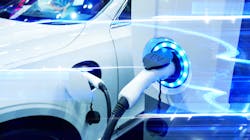AEP to Switch 100% of Cars, Light-Duty Trucks to EVs by 2030
American Electric Power (AEP) recently announced it will accelerate its electric vehicle (EV) purchases with the goal of replacing 100% of its 2300 cars and light-duty trucks with EV alternatives by 2030. The AEP's total fleet is composed of nearly 8000 vehicles, including medium- and heavy- duty vehicles. By converting medium- and heavy-duty vehicles as electric or hybrid models become available, the AEP will achieve its goal of electrifying 40% of its entire on-road vehicle fleet in less than 10 years.
"The AEP has made great progress in reducing the carbon dioxide (CO2) output of our power generation fleet, cutting emissions by 65% since 2000 and setting a goal to achieve a more than an 80% reduction, and aspiring to be net-zero by 2050," said Nicholas K. Akins, AEP chairman, president, and chief executive officer. "Through our commitment to transitioning to EVs, we will cut tailpipe emissions, reduce operating costs, and encourage other companies that rely on large vehicle fleets to switch to battery or hybrid vehicles."
The AEP estimates that it will avoid using more than 10 million gallons of fuel, amounting to a US$40 million savings in fuel costs, over the life of the vehicles. Transitioning light-duty vehicles to EVs has been part of the AEP's fleet strategy and will now become the standard across its subsidiaries. The company will also electrify 50% of its forklifts by 2030.
The AEP's fleet currently consists of 85 EVs and employees are able to use more than 230 charging ports installed at locations throughout its 11-state service territory. The company is also working with customers and communities to share the benefits of electric transportation and support EV adoption. It has created programs, such as incentives for charging station installations, off-peak charging programs, energy efficiency rebates, and consultative services to encourage electrification.
For example, AEP Ohio is deploying 375 charging stations in partnership with local governments, workplaces, multifamily dwellings, and low-income areas to increase publicly-available charging sites and demonstrate the benefit of public-private partnerships. Indiana Michigan Power customers can participate in rebate programs that reduce EV charging infrastructure costs and use EV-specific off-peak rates to reduce their charging costs. AEP subsidiaries continue to develop and deploy programs to optimize the electric grid and bring the benefits of electric transportation to all customers.
The AEP has partnered with ChargePoint to offer tailored evaluations for commercial and industrial customers considering electrifying their fleets. This partnership offers customers the opportunity to learn about available incentives, the latest in charging technologies, and how to ensure that the local utility grid is used efficiently. Fleet electrification offers many advantages, but requires companies to evaluate their site, their local electric facilities, and navigate a wide array of charging equipment options. This partnership helps streamline the information gathering and decision-making process for businesses interested in switching their fleets to EVs.
For more information on the AEP's sustainability plan, visit here.
